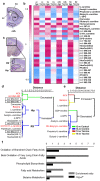Integration of Mass Spectrometry Imaging and Machine Learning Visualizes Region-Specific Age-Induced and Drug-Target Metabolic Perturbations in the Brain
- PMID: 33939923
- PMCID: PMC8291481
- DOI: 10.1021/acschemneuro.1c00103
Integration of Mass Spectrometry Imaging and Machine Learning Visualizes Region-Specific Age-Induced and Drug-Target Metabolic Perturbations in the Brain
Abstract
Detailed metabolic imaging of specific brain regions in early aging may expose pathophysiological mechanisms and indicate effective neuropharmacological targets in the onset of cognitive decline. Comprehensive imaging of brain aging and drug-target effects is restricted using conventional methodology. We simultaneously visualized multiple metabolic alterations induced by normal aging in specific regions of mouse brains by integrating Fourier-transform ion cyclotron resonance mass spectrometry imaging and combined supervised and unsupervised machine learning models. We examined the interplay between aging and the response to tacrine-induced acetylcholinesterase inhibition, a well-characterized therapeutic treatment against dementia. The dipeptide carnosine (β-alanyl-l-histidine) and the vitamin α-tocopherol were significantly elevated by aging in different brain regions. l-Carnitine and acetylcholine metabolism were found to be major pathways affected by aging and tacrine administration in a brain region-specific manner, indicating altered mitochondrial function and neurotransmission. The highly interconnected hippocampus and retrosplenial cortex displayed different age-induced alterations in lipids and acylcarnitines, reflecting diverse region-specific metabolic effects. The subregional differences observed in the hippocampal formation of several lipid metabolites demonstrate the unique potential of the technique compared to standard mass spectrometry approaches. An age-induced increase of endogenous antioxidants, such as α-tocopherol, in the hippocampus was detected, suggesting an augmentation of neuroprotective mechanisms in early aging. Our comprehensive imaging approach visualized heterogeneous age-induced metabolic perturbations in mitochondrial function, neurotransmission, and lipid signaling, not always attenuated by acetylcholinesterase inhibition.
Keywords: Acetylcholine; aging; brain metabolomics; lipids; mass spectrometry imaging; tacrine.
Conflict of interest statement
The authors declare no competing financial interest.
Figures






References
Publication types
MeSH terms
Substances
LinkOut - more resources
Full Text Sources
Other Literature Sources
Medical

